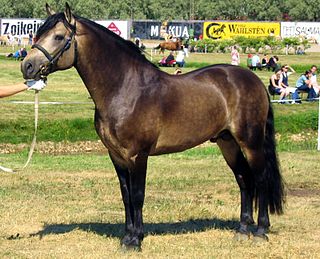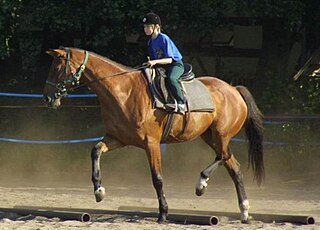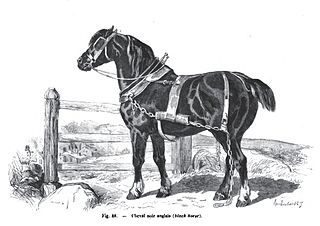 W
WThe Angevin is an extinct breed of light saddle-horse from the former province of Anjou in western France. It was bred principally in the area around Angers in the département of Maine-et-Loire. It stood about 149–157 centimetres at the withers. It was much used as a mount for light cavalry. The Angevin was merged with other French regional breeds of riding horse, including the Anglo-Normand, the Charentais, the Charolais and the Vendéen, to create the Selle Français in 1958.
 W
WThe Anglo-Norman horse is a warmblood horse breed developed in Lower Normandy in northern France. A major center of horse breeding, the area had numerous regional types that were bred to one another and then crossed with Thoroughbreds to form the Anglo-Norman. Various body types developed within the Anglo-Norman breed, two of which were split off to form the Norman Cob and French Trotter. The remaining types were eventually standardized, although there remained some criticism of the "hybrid" nature of the breed's conformation. However, it is successful as an international sport horse, especially in the sport of show jumping. The Anglo-Norman also contributed to the development of several other breeds in Europe and Asia.
 W
WThe Berrichon is an extinct breed of horse from central France. It was bred principally in the area around Berry, France. It was used in public transportation by the General Omnibus Company to pull buses in Paris between 1855 and 1900. The remnants of the breed were merged into the Percheron in 1966.
 W
WThe Bidet was a type of small horse from France, now extinct. It was a landrace developed principally in the area around Brittany, Morvan, Auvergne, Poitou, and Burgundy. It stood about 110–135 centimetres at the withers. Two distinct groups are documented, which were bred in a semi-feral state.
 W
WThe Charentais and Vendéen are extinct breeds of horse from western France. They were bred principally in the area around Poitou-Charentes and Vendée, France. They were used as a mount for light cavalry.
 W
WThe Charolais or Charollais is an extinct breed of warmblood horse from the Charolais, the country lying around the town of Charolles, now in the Saône-et-Loire département of Burgundy, in eastern central France. Like other French warmbloods, it was the result of crossing local agricultural horses with the Thoroughbred, and was known by the name of the region without ever having a specific stud-book. Like other French warmbloods including the Angevin, the Charentais, the Cheval Limousin and the Vendéen, it was fused with the Anglo-Normand in 1958 in order to create the national warmblood stud-book, the Selle français. It was originally used as a multi-purpose horse for riding, driving, and agriculture. During the late 19th century, additional Thoroughbred blood was added and a new type emerged that was principally used as a light cavalry mount. It was also used for dressage and show jumping.
 W
WFerghana horse were one of China's earliest major imports, originating in an area in Central Asia. These horses, as depicted in Tang dynasty tomb figures in earthenware, "resemble the animals on the golden medal of Eucratides, King of Bactria ."
 W
WThe Irish Hobby is an extinct breed of horse developed in Ireland prior to the 13th century. The breed provided foundation bloodlines for several modern horse breeds, including breeds as diverse as the Connemara pony and the Irish Draught. Palfreys were known as haubini in France, which eventually became hobbeye. These animals eventually found their way to Ireland where the Irish Hobby developed.
 W
WA jennet or Spanish jennet was a small Spanish horse. It was noted for a smooth naturally ambling gait, compact and well-muscled build, and a good disposition. The jennet was an ideal light riding horse, and as such spread across Europe and provided some of the foundation bloodstock for several horse breeds in the Americas.
 W
WThe Limousin horse was a French breed of horse. It is now extinct.
 W
WThe Wielkopolski is a breed of horse that was originated in Central and Western Poland in 1964, and is occasionally known as Mazursko-Poznanski. Its name derives from Wielkopolska, a region in west central Poland centred on Poznań.
 W
WThe Wielkopolski is a breed of horse that was originated in Central and Western Poland in 1964, and is occasionally known as Mazursko-Poznanski. Its name derives from Wielkopolska, a region in west central Poland centred on Poznań.
 W
WThe Narragansett Pacer was the first horse breed developed in the United States, but is now extinct. It was developed in the United States during the 18th century and associated closely with the state of Rhode Island, and it had become extinct by the late 19th century. The Pacer was developed from a mix of English and Spanish breeds, although the exact cross is unknown, and they were known to and owned by many famous personages of the day, including George Washington. Sales to the Caribbean and cross-breeding diminished the breed to the point of extinction, and the last known Pacer died around 1880.
 W
WThe Cheval Navarrin, also called Navarin, Navarrois, Tarbais, Tarbésan or Bigourdin, is an extinct breed of light saddle-horse from south-western France. It was bred principally in the plains of the Pyrenees around Tarbes, and in Bigorre, now in the Hautes-Pyrénées. It stood about 148–151 centimetres at the withers. Lively and elegant, it had an excellent reputation throughout the 18th century. It was used as a mount for light cavalry, as a saddle-horse and for classical dressage.
 W
WThe Neapolitan Horse, Italian: (Cavallo) Napoletano, Neapolitano or Napolitano, is a horse breed that originated in the plains between Naples and Caserta, in the Campania region of Italy, but which may have been bred throughout the Kingdom of Naples. The Neapolitan horse was frequently mentioned in literature from the 16th to the 19th centuries, and is noted for its quality. Corte wrote in 1562: "in Italy the horses of the Kingdom of Naples are greatly esteemed; [there] many fine coursers are born ... suitable for use in war and in the manège and for every service that the rider may require". The decline of the breed was noted in the early 20th century by Mascheroni (1903) and Fogliata (1908). Some sources state that by 1950, the original Neapolitan horse was deemed extinct, but its lines were incorporated into other breeds, most notably the Lipizzaner. However, a breed called the Napolitano exists in Italy today, and is recognized by the Italian government. According to Gouraud, "a dedicated breeder ... is hoping to be able to rebuild it". La Repubblica reports that the attempt is based on a single stallion, Neapolitano "Il Vecchio", which belonged as a foal to Marshal Tito and passed when old to a Serbian farmer, from whom it was purchased and imported to Italy in 1989.
 W
WThe Norfolk Trotter is an extinct horse breed once native to East Anglia and Norfolk, England. It was said to be "a large-sized trotting harness horse originating in and around Norfolk".
 W
WThe Old English Black is an extinct horse breed.
 W
WThe Wielkopolski is a breed of horse that was originated in Central and Western Poland in 1964, and is occasionally known as Mazursko-Poznanski. Its name derives from Wielkopolska, a region in west central Poland centred on Poznań.
 W
WThe Turkoman horse, or Turkmene, was an Oriental horse breed from the steppes of Turkoman desert. Its closest modern descendant is thought to be the Akhal-Teke. It influenced many modern horse breeds, including the Thoroughbred horse. Some horses bred in Iran and Turkmenistan today are still referred to as Turkoman, and have similar characteristics.
 W
WThe Yorkshire Coach Horse is an extinct horse breed once native to England. It was a large, strong, bay or brown horse with dark legs, mane and tail. It was said to be "a longer-legged carriage horse with unmatched ability for a combination of speed, style, and power" and "a tall, elegant carriage horse".